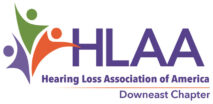 On Feb 9, 2023, our chapter hosted a fascinating two-our Zoom presentation by Larry Medwetsky, Ph.D entitled
On Feb 9, 2023, our chapter hosted a fascinating two-our Zoom presentation by Larry Medwetsky, Ph.D entitled
”Everything You Always Wanted to Know About Hearing Aids” all about recent advances in hearing aid technology.
Please review Larry’s Click here for Larry’s PowerPoint presentation. and you may watch a recording of his presentation here. The link requires a code which is 0j!k@VbR . Please respect the privacy of the individuals named in the Chat area at the recording’s link.
Below is a summary of the plethora of info provided. Start time of topics are approximate.
- Introductions by Pat.
- HLAA DownEast Chapter in Maine is now an official part of the Hearing Loss Association of America.
- 0:05:00 Andy previewed his upcoming cybersecurity presentation.
- 0:11:30 Larry’s presentation begins.
- This meeting has about 18 slides, but his powerpoint has additional slides.
- Focus is on high end prescriptive hearing aids, along with advances over the past 10 years.
- Prescriptive aids are obtained via an audiologist.
- High $ aids typically have more features.
- 0:20:00 More channels allow more capabilities. Hearing aids have from 3 to 24 channels, with 8 most common.
- 0:26:00 Feedback from microphones significantly reduced.
- 0:36:00 Automatic Adaptive Directionality.
- Aids are better at locating the source of a sound (talk or music), and thus improve hearing up to 50% vs older aids.
- Digital aids “can scan the full 360° sound environment more than 100 times per second”.
- 0:44:14 Wind noise is reduced greatly.
- 0:50:51 Brief silence 1 of 2, to let attendees’ brains rest. Came after a short Q&A which just had comments.
- 0:51:35 Echos physically blur words. Software fixes these reverberations.
- 0:56:39 Artificial intelligence began circa 2008 CE for aids, and a more advanced AI arrived in 2022.
- Many hearing aid software gets trained by AI before they are sold. Some trained aids can handle 55 million different situations.
- A “website that explains how AI can help in hearing aids” is https//www.audiologycharlotte.com/blog/artificial-intelligence-in-hearing-aids .
- 1:03:50 Frequency Shifting (aka Lowering) moves sounds from frequencies you hear poorly to those you hear significantly better.
- 1:09:00 Receiver Module With Canal Microphone is a technical section. Improves hearing and reduces mental effort needed by the listener.
- 1:15:00 Brief silence 2 of 2 for mental rest.
- 1:15:21 Rechargeable Hearing Aids have many advantages, and only a couple drawbacks.
- Rechargeable batteries help HOH folks with additional accessibility issues such as poor vision or low dexterity (e.g, arthritis) .
- Connectivity (e.g, Bluetooth) postponed due to time limitations, but is included in the powerpoint link.
- 1:23:00 Tinnitus aka ringing in your ears can be masked by aids that generate soothing sounds.
- 1:25:20 Musical distortion reduced. Recent microphones can handle music of 113 dB (decibels) whereas older ones maxed out at 100 dB.
- 1:26:00 Q&A etc.
- Check in often with your audiologist, since advances are happening rapidly. Software advances move to cheaper aids much quicker than hardware changes did.
- An aid that sends an SOS when you fall might be coming soon.
- Folks who can hear but not understand (sometimes called Auditory Listening Disorder), and those who prefer visual to audio input, usually have biological issues in their brain or ears. Thus aids won’t help this directly. However, technology can enhance visual input such as lip reading.
- 1:26:30 Wrap up.
- Technology of the near future might let HOH and deaf folks do things “normal” folks cannot.
- Gwen asked a question about playing music, but the captions glitched.
- The next meeting HLAA Down East Chapter hosts via Zoom will be Thursday April 6, 2023.
Side notes:
- Candidates for cochlear implants are lately sticking with aids because of these new features. Some features are also in recent implants, however, that’s a separate topic.
- Many aid makers have apps for cell phones etc. Some apps let you adjust things that only audiologists could do before recent software advances.
Humorous and other captioning goofs during this presentation follow. We must laugh, else we despair.
- Someone “had lifelong hearing moss” vs loss.
- Someone else had “startled fever” vs scarlet.
- This feature makes it “easier to here at a Thanksgiving jail” vs hear and what?!
- “No more remotely, and only the designer to be transmitted.” = huh?
Technical note and plea for advocacy:
- The video’s captions sometimes obscure the bottom portion of slides. This is particularly annoying when the obscured part has pointer movement explaining stuff. Turn CC off to see the slide’s info, and don’t forget to turn CC back on.
- Please let video makers, as well as the company whose software they use, know that obscuring things is unfriendly and reduces effectiveness of accessibility features. If they say “you can just hide the CC”, let them know that it wastes our valuable time by requiring at least 1 replay at each hidden spot.
Written on Feb 15, 2023, by Thomas F Watson III, secretary of HLAA DownEast Chapter. Any errors in this article are solely due to Thomas’ interpretation or his own mistakes.

